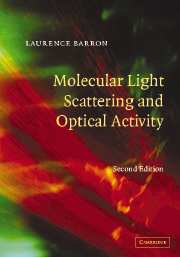Book contents
- Frontmatter
- Contents
- Preface to the first edition
- Preface to the second edition
- List of symbols
- 1 A historical review of optical activity phenomena
- 2 Molecules in electric and magnetic fields
- 3 Molecular scattering of polarized light
- 4 Symmetry and optical activity
- 5 Natural electronic optical activity
- 6 Magnetic electronic optical activity
- 7 Natural vibrational optical activity
- 8 Antisymmetric scattering and magnetic Raman optical activity
- References
- Index
7 - Natural vibrational optical activity
Published online by Cambridge University Press: 07 August 2009
- Frontmatter
- Contents
- Preface to the first edition
- Preface to the second edition
- List of symbols
- 1 A historical review of optical activity phenomena
- 2 Molecules in electric and magnetic fields
- 3 Molecular scattering of polarized light
- 4 Symmetry and optical activity
- 5 Natural electronic optical activity
- 6 Magnetic electronic optical activity
- 7 Natural vibrational optical activity
- 8 Antisymmetric scattering and magnetic Raman optical activity
- References
- Index
Summary
What Emanations
Quick vibrations
And bright stirs are there?
Henry Vaughan (Midnight, from Silex Scintillans)Introduction
We now turn from the established topic of electronic optical activity to the newer topic of optical activity originating in transitions between the vibrational levels of chiral molecules. Absorption of infrared radiation and Raman scattering of visible radiation provide two distinct methods for obtaining a vibrational spectrum. We shall be concerned equally with manifestations of vibrational optical activity in infrared and Raman spectra. As described in Section 1.5, these take the form of optical rotation and circular dichroism of infrared radiation, and a difference in the intensity of Raman scattering in right- and left-circularly polarized incident light or, equivalently, a circular component in the scattered light using fixed incident polarization.
The fundamental description of natural vibrational optical rotation and circular dichroism parallels the electronic case, being linear in components of the tensors G′αβ and Aα,βμ, except that now the molecule remains in the ground electronic state into which excited electronic states are mixed by vibrational perturbations. On the other hand, the description of natural vibrational Raman optical activity involves cross terms between components of the tensor αββ with the tensors G′αβ and Aα,βμ, with excited electronic states providing the pathway for the scattering of visible light. It is the variation of these tensors with the normal coordinates of vibration that brings about the vibrational Raman transitions.
- Type
- Chapter
- Information
- Molecular Light Scattering and Optical Activity , pp. 331 - 384Publisher: Cambridge University PressPrint publication year: 2004

